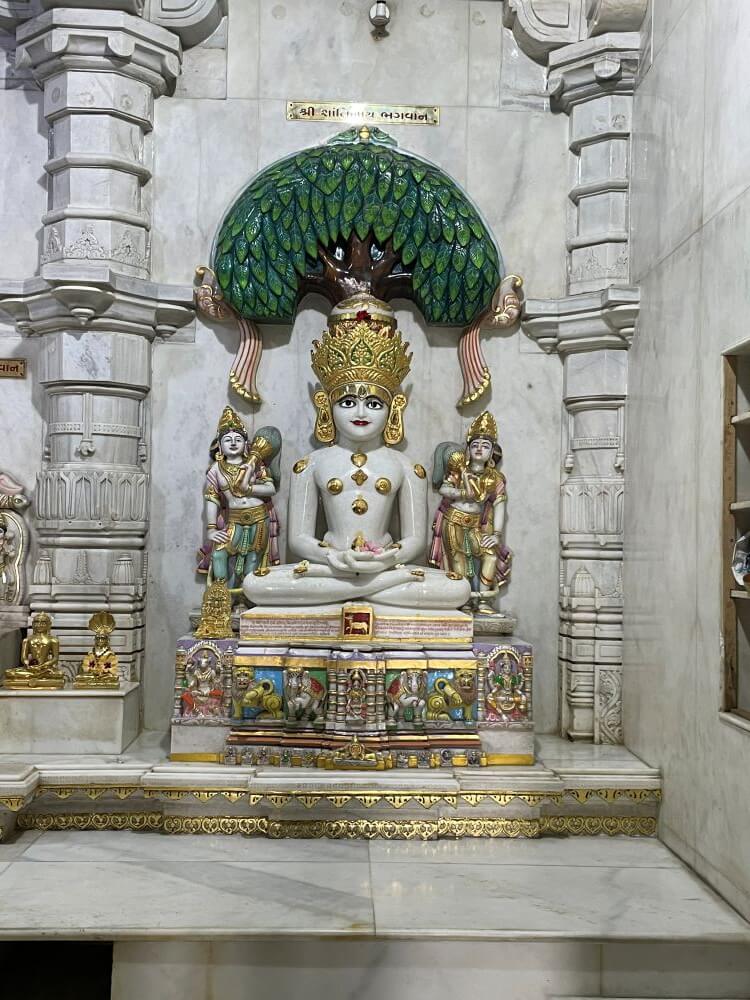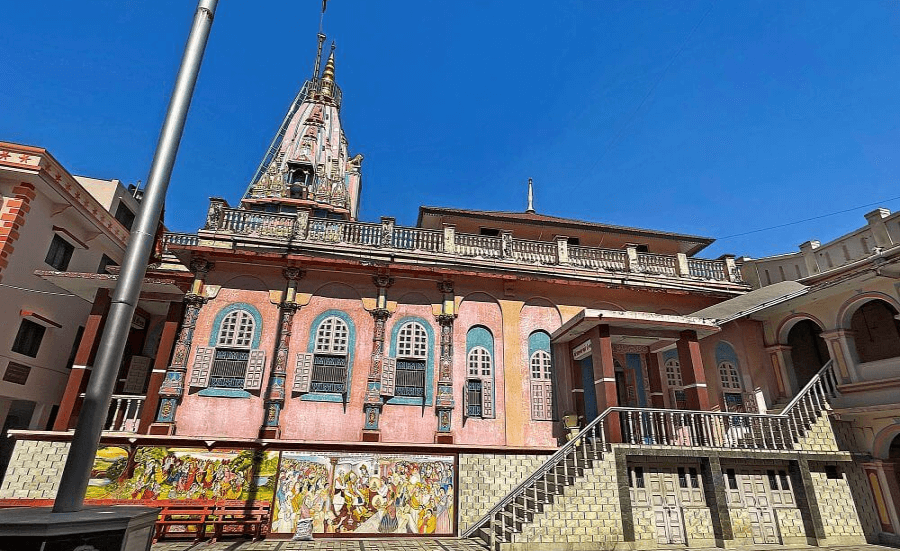
 The ‘Mahaprabhavak Shankheshwar Parshvanath Bhagwan Temple’ located in Baleshwar is dedicated to Lord Parshvanath, the 23rd Tirthankara of Jainism who led a peaceful revolution against violence. Established under the inspiration of Jain saint Labdhi-Vikram Rajyash Surishwarji, this temple is also known as Sarvoday Tirth. The temple is magnificent, situated in a vast area amid natural surroundings. The temple showcases the characteristic features of Jain temples including intricate sculpture work, detailed stone carvings and beautiful idols of Tirthankaras and deities like Yaksha-Yakshini. The peaceful and spiritual atmosphere of this place continuously attracts devotees.
The ‘Mahaprabhavak Shankheshwar Parshvanath Bhagwan Temple’ located in Baleshwar is dedicated to Lord Parshvanath, the 23rd Tirthankara of Jainism who led a peaceful revolution against violence. Established under the inspiration of Jain saint Labdhi-Vikram Rajyash Surishwarji, this temple is also known as Sarvoday Tirth. The temple is magnificent, situated in a vast area amid natural surroundings. The temple showcases the characteristic features of Jain temples including intricate sculpture work, detailed stone carvings and beautiful idols of Tirthankaras and deities like Yaksha-Yakshini. The peaceful and spiritual atmosphere of this place continuously attracts devotees.
Jainism recognizes 24 Tirthankaras in total. Lord Mahavira was the last Tirthankara and Lord Parshvanath preceded him. According to historical accounts, Parshvanath was born in Kashi around 850 BCE, about 250 years before Mahavira. His parents were King Ashvasen and Queen Vamadevi and he was born on the eleventh day of the dark fortnight in the month of Pausha. He married Princess Prabhavati, daughter of King Prasenjit of Ayodhya. At the age of thirty, after hearing the ‘Rishabhadeva Charita’ in the royal court, he renounced worldly life and embraced asceticism. A well-known story in Jain tradition highlights Parshwanath’s compassion and divine protection. Legend has it that while Parshvanath was meditating, an evil spirit from his previous life tried to harm him with a torrential downpour, but a grateful serpent king from a previous life protected him by forming an umbrella with his seven hoods. In Jain tradition, each Tirthankara has a distinct symbol by which their idol is identified. The seven-hooded serpent is considered Parshvanath’s symbol.
but a grateful serpent king from a previous life protected him by forming an umbrella with his seven hoods. In Jain tradition, each Tirthankara has a distinct symbol by which their idol is identified. The seven-hooded serpent is considered Parshvanath’s symbol.
According to Jain scriptures, Lord Parshwanath is said to have undergone nine previous births before attaining his final form as a Tirthankara. In his first birth, he was a Brahmin named Marubhumi. In his second birth, he was an elephant named Vajraghosh. In his third birth, he was a heavenly deity, in his fourth he was King Rashmiveg, in his fifth he was a deity, in his sixth he was Emperor Vajranabhi, in his seventh he was a deity, in his eighth he was King Anand and in his ninth he was Indra. In his tenth birth, he became a Tirthankara. Parshvanath attained moksha at the age of 100 on Sammetshikhar in Jharkhand. This place is now famous as ‘Parasnath Hill’. Numerous idols and temples of Parshvanath are found throughout India and the temple in Baleshwar is one of them.
This Shwetambar Jain temple, enclosed within tall boundary walls, is adorned with trees and gardens. The courtyard is completely paved with paver blocks. Upon entering through the main gate, one first encounters a canopied structure with busts of the philanthropic Kamdar couple from Surat who donated the land for the temple. Proceeding further, one comes across the dhwajdand (flagpole).
The temple itself is an architectural marvel, built entirely in white marble and elevated on a high platform (jagati). The temple has three beautiful entrance arches – the central arch being taller than the two side arches. These arches are supported by intricately carved circular pillars featuring serpent hoods, trident-bearing Shiva and goddess figures. The temple has many such pillars with various small and large carved figures. From the archways, a wide staircase of approximately 25 marble steps leads up to the temple. The stairway’s balustrades are adorned with intricately sculpted Sheshnag-shaped gatekeepers.
The temple follows a traditional Jain temple design, comprising four key sections: mukhamandapa (entrance hall), rangamandapa (assembly hall), antarala (vestibule) and garbhagriha (sanctum sanctorum). The temple has eight spires of varying sizes. The mukhamandapa and rangamandapa have subsidiary spires in the Phamsana style of architecture, with numerous small pinnacles on their pyramid-like shapes. The main temple spire follows the Nagara style of architecture with the Urushring pattern, meaning smaller spires surrounding a central tall spire, topped with an amalaka and pinnacle.
The temple’s mukhamandapa has circular pillars carved with figures of deities, attendants (Riddhi) and Tirthankaras, supporting a domed ceiling. Five steps lead up to the rangamandapa, which has three entrances. The doorframe pillars here also feature guardian deities and attendant figures and the lintels have crescent-shaped stones similar to Hindu temples. The spacious rangamandapa and antarala, adorned with beautiful carvings, have niches containing various deity and saint idols. These include Ghantakarna Mahavir (a protective deity in Jain tradition), the black stone Kshetrapala Dada protected by a magnificent serpent king, Osiyamata (the clan goddess of the Oswal community) and the idol of Acharya Shri Vikramsuriji. The niches also house a black stone idol of Mahaprabhavak Shankheshwar Parshvanath and a marble idol of the fifth Tirthankara, Sumatinath Bhagwan.
Five steps lead up to the rangamandapa, which has three entrances. The doorframe pillars here also feature guardian deities and attendant figures and the lintels have crescent-shaped stones similar to Hindu temples. The spacious rangamandapa and antarala, adorned with beautiful carvings, have niches containing various deity and saint idols. These include Ghantakarna Mahavir (a protective deity in Jain tradition), the black stone Kshetrapala Dada protected by a magnificent serpent king, Osiyamata (the clan goddess of the Oswal community) and the idol of Acharya Shri Vikramsuriji. The niches also house a black stone idol of Mahaprabhavak Shankheshwar Parshvanath and a marble idol of the fifth Tirthankara, Sumatinath Bhagwan.
In the Garbha-griha (sanctum sanctorum), the central focus is a majestic idol of Lord Shankheshwar Parshwanath, enshrined on a high pedestal within an intricately carved stone canopy (makhara). The idol is in padmasana (lotus position) and wears a jewel-studded golden crown. Below the idol is carved the image of a serpent, Parshvanath’s symbol. Below the canopy are carved figures of Ganesha, Lakshmi, as well as sculptures of lions and elephants. The pillars on both sides of the canopy feature Tirthankara idols in both kayotsarga (standing meditation) and padmasana postures. Above the canopy are three golden umbrellas, stacked one above the other.  These umbrellas represent the sovereignty of Lord Parshwanath over the three realms: Adholoka (lower realm), Madhyaloka (middle realm) and Devaloka (celestial realm).
These umbrellas represent the sovereignty of Lord Parshwanath over the three realms: Adholoka (lower realm), Madhyaloka (middle realm) and Devaloka (celestial realm).
Adjacent to Parshvanath’s idol, on the left is Lord Sambhavnath’s idol and on the right is Lord Munisuvrata Swami’s idol, both in padmasana. In the canopy to the left is the padmasana idol of the first Tirthankara, Adinath Bhagwan (Rishabdev), while on the right is the idol of the sixteenth Tirthankara, Shantinath Bhagwan.
In one of the shrine rooms (devakulika) adjacent to the sanctum is the idol of Manibhadravir, depicted with eight arms and a boar face, seated on an elephant with six trunks. The other shrine room houses the idol of Padmavati Rajrajeshwari, Lord Parshvanath’s protective deity (Shasandevata).
Daily rituals at the temple begin at 7:15 AM with the Vakshep Puja, where a mixture of sandalwood powder and rose water is applied from a distance. This is followed by the Shankhnad (conch-blowing), bell-ringing and various musical instruments accompanying the Pakshal Puja (ritual bathing with milk-mixed water). At 8 AM, the eight-fold worship ritual takes place, including offerings of water, sandalwood, flowers, incense, lamps, rice, food and flowers. Additionally, devotional singing programs are organized every Saturday, Sunday and on full moon days.
The temple is also known by the name of Labdhi-Vikram Rajyash Surishwarji, who was an Acharya (preceptor) of the Shwetambar Murtipujak sect of Jainism and a disciple of Acharya Vikramsuri. Acharya Rajyash Surishwarji, who walked over 100,000 kilometers for religious propagation, is multilingual, having mastery over Hindi, Gujarati, Sanskrit, Prakrit and English. His expertise spanned multiple disciplines, including Jain Agamas, grammar, logic, philosophy, yoga, astrology, mantras and architecture. He authored around 25 religious texts, contributing significantly to Jain literature and philosophy.



